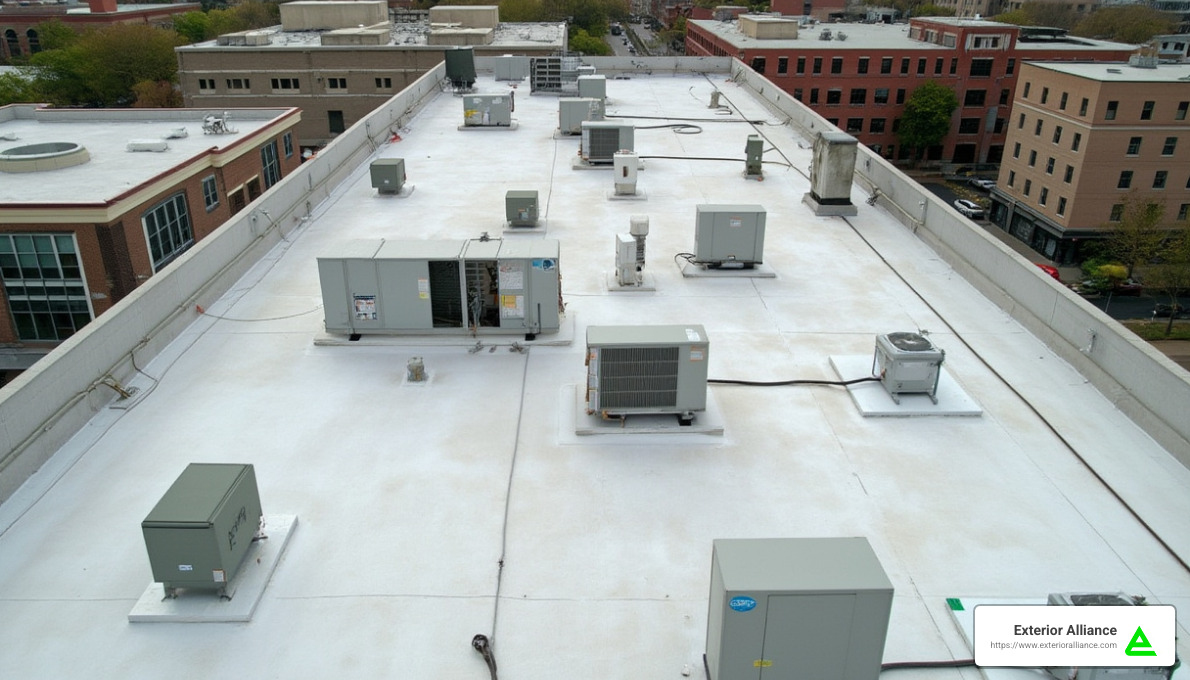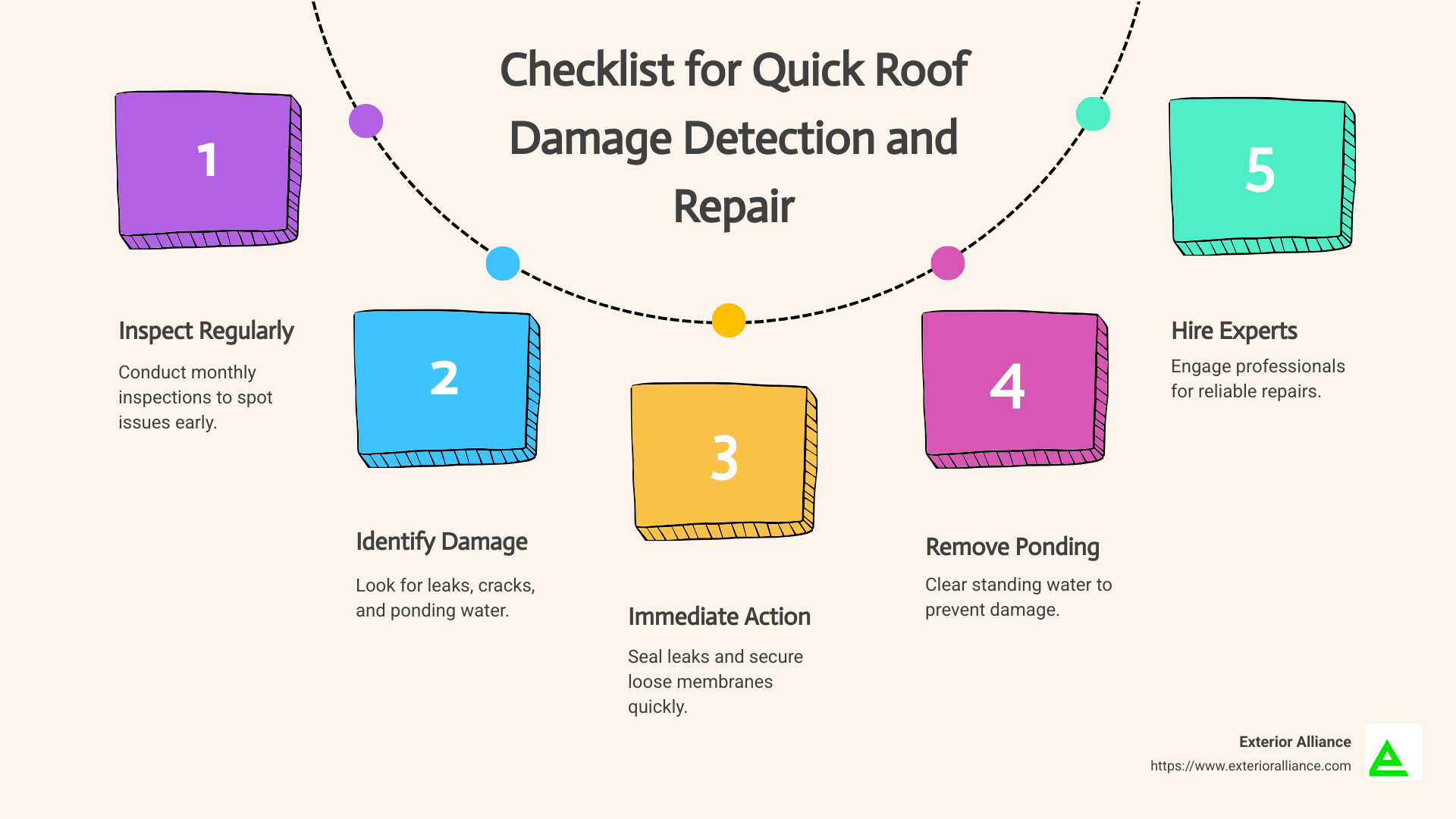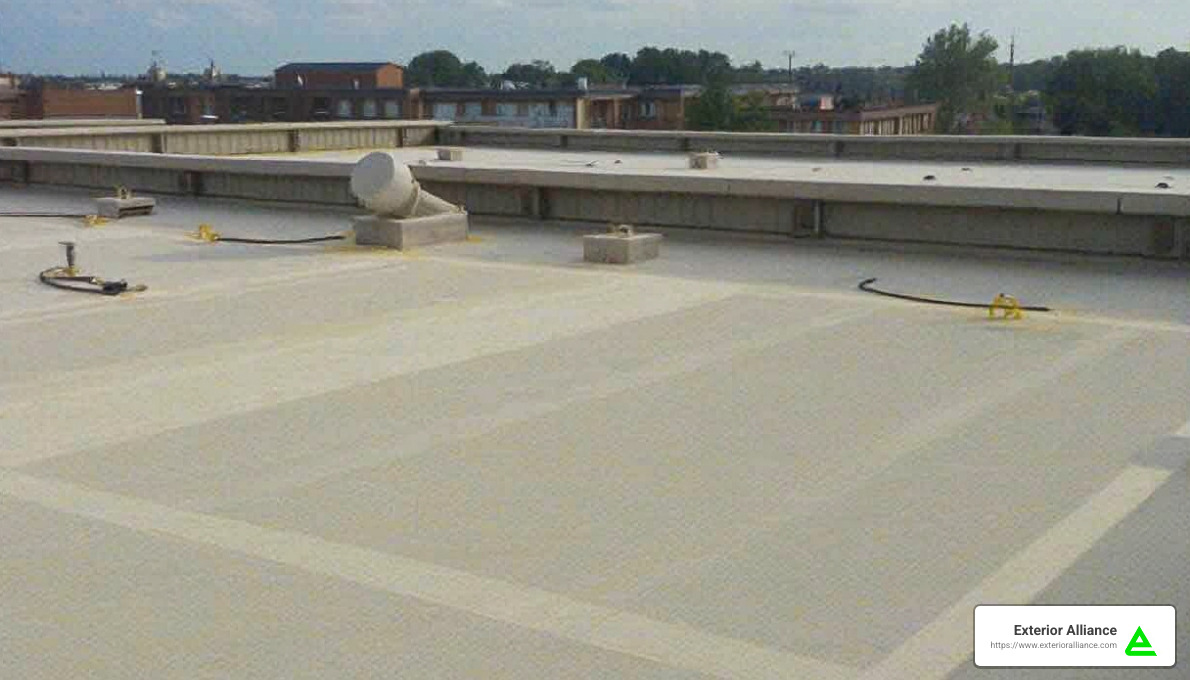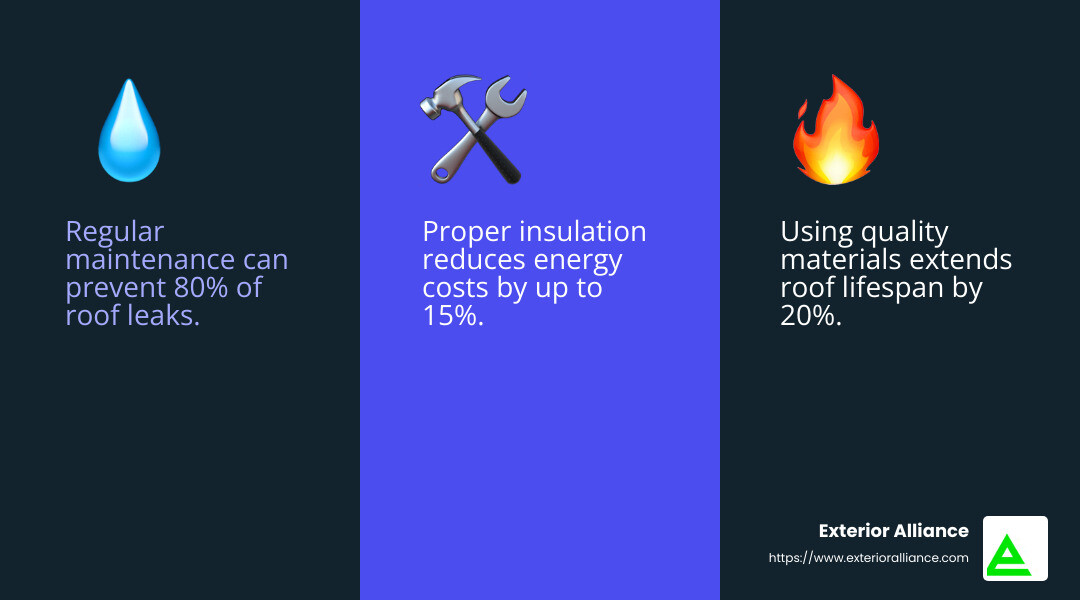
Commercial flat roof repair is essential for maintaining the integrity and functionality of your business facilities. Here’s a quick guide to help you address common issues:
- Identify Damage: Look for leaks, cracks, ponding water, or membrane damage.
- Immediate Action: Seal leaks, remove ponding water, and secure loose membranes.
- Hire experts: Engage professional contractors for reliable repairs and maintenance.
Flat roofs are a common choice for commercial buildings due to their affordability and efficient use of space. They facilitate easy installation and provide a practical solution for businesses. However, these roofs also require regular attention to prevent long-term damage.
Proper maintenance is key. Frequent checks can catch early signs of trouble like water leaks or structural damage. Acting swiftly to address these issues ensures the roof stays in good condition and prolongs its lifespan.
Keeping your commercial flat roof in top shape is critical to avoiding costly repairs and disruptions. With the right maintenance strategy, you can enjoy peace of mind knowing your business is protected.

Understanding Commercial Flat Roofs
Flat roofs are a popular choice for commercial buildings, thanks to their cost-effectiveness and simplicity. These roofs are typically less expensive to install and maintain than pitched roofs, making them an attractive option for businesses.
Common Materials Used in Commercial Flat Roofs
Let’s explore some of the common materials used in commercial flat roof repair and construction:
- EPDM (Ethylene Propylene Diene Monomer): This synthetic rubber is known for its durability and resistance to weathering. It’s a great choice for flat roofs because it can withstand extreme temperatures and UV exposure. EPDM is also flexible, which helps it adapt to temperature changes without cracking.
- TPO (Thermoplastic Olefin): TPO roofs are gaining popularity due to their energy efficiency and ease of installation. They are heat-reflective and can help reduce cooling costs, making them an environmentally friendly choice. TPO is also resistant to dirt, mold, and punctures, which can reduce maintenance needs.
- PVC (Polyvinyl Chloride): PVC roofing is known for its strength and long lifespan. It offers excellent resistance to chemicals, fire, and wind, making it a reliable choice for commercial buildings. PVC roofs are also highly reflective, which can contribute to energy savings.
- Built-Up Roofing (BUR): This traditional roofing method involves layering tar and gravel, creating a durable and waterproof surface. BUR is known for its longevity and ability to withstand heavy foot traffic. However, it can be more labor-intensive to install compared to other materials.

Why Choose a Flat Roof?
The main advantages of flat roofs include:
- Affordability: Flat roofs typically use fewer materials and require less labor to install, making them cost-effective.
- Space Utilization: They provide usable space for HVAC systems, solar panels, or even rooftop gardens.
- Easy Access: Flat roofs are easier and safer to access for maintenance and inspections.
However, it’s important to note that flat roofs can be more prone to water pooling and leaks. Regular maintenance and inspections are crucial to prevent these issues and extend the roof’s lifespan.
By understanding the materials and benefits of flat roofs, businesses can make informed decisions about their roofing needs. In the next section, we’ll dig into recognizing signs that your commercial flat roof needs repair.
Signs Your Commercial Flat Roof Needs Repair
Spotting early signs of damage on your commercial flat roof can save you from costly repairs down the line. Here are some key indicators that your roof might need attention:
Interior Water Stains
Water stains on ceilings or walls are a telltale sign of a roof leak. These stains often appear as discolored patches and can indicate water infiltration through damaged roofing materials. If you notice these, it’s crucial to address them promptly to prevent further water damage.
Odors and Mold
Unpleasant odors or visible mold growth inside your building can signal moisture problems. Mold thrives in damp environments, and its presence often points to water seeping through the roof. This not only affects air quality but can also lead to health issues for building occupants.
Visible Damage
Regularly inspect your roof for visible damage, such as cracks, blisters, or punctures in the roofing material. These can compromise the roof’s integrity, allowing water to penetrate and cause further damage. Pay close attention to the seams and edges of the roof, as these areas are particularly vulnerable.
Blocked Drains
Flat roofs are notorious for poor drainage. Blocked drains can lead to ponding water, which puts extra weight on the roof and accelerates deterioration. Ensure that drains and gutters are clear of debris to facilitate proper water runoff and prevent potential leaks.
By keeping an eye out for these signs, you can catch problems early and extend the life of your commercial flat roof. Regular inspections and maintenance are key to avoiding costly repairs and ensuring your roof continues to protect your business.
Next, we’ll explore effective techniques for repairing common issues found in commercial flat roofs.
Effective Commercial Flat Roof Repair Techniques
When it comes to commercial flat roof repair, addressing issues like leaks and water damage, ponding water, and membrane damage is crucial. Let’s explore some effective techniques for tackling these common problems.
Leaks and Water Damage
Leaks can cause serious damage if not promptly repaired. Here’s how to handle them:
Find the Source: Start by identifying the leak’s origin. Look for water stains on the ceiling and trace them back to the roof.
Repair Damaged Areas: Once you’ve located the leak, replace or repair the damaged roofing materials. This might involve patching up tears or replacing sections of the membrane.
Seal Gaps: Use appropriate sealants or flashing to close any gaps or joints. This prevents future water infiltration.
Install Drainage Systems: Effective drainage is key. Consider adding or improving drainage systems to redirect water away from the roof, thus preventing ponding.
Ponding Water
Ponding water can weaken the roof structure over time. Here’s how to address it:
Improve Drainage: Check the roof’s drainage system and clear any blockages. Ensure water flows away from the roof efficiently.
Level the Roof Surface: A properly leveled roof surface encourages water to drain off. Consider using tapered insulation or roof coatings to facilitate water runoff.
Regular Maintenance: Regularly inspect and maintain your drainage systems to prevent future ponding.
Membrane Damage
The roof membrane is crucial for keeping water out. Damage to it can lead to leaks and other issues. Here’s how to repair it:
Patch Tears and Punctures: Use appropriate patching materials to fix any tears or punctures in the membrane. Ensure the patches are securely bonded.
Secure Loose Sections: Overlap or secure any loose sections of the membrane to prevent further damage.
Adhesion Test: Regularly test the membrane’s adhesion to the roof substrate. This helps ensure it remains intact during strong winds and adverse weather conditions.
By applying these repair techniques, you can effectively address common issues with your commercial flat roof. Proper repairs not only fix current problems but also help prevent future ones, ensuring the longevity and reliability of your roof.
Next, we’ll explore the best practices for maintaining commercial flat roofs to keep them in top condition.
Best Practices for Maintaining Commercial Flat Roofs
Keeping your commercial flat roof in good shape is essential for its longevity and performance. Here are some best practices to ensure your roof stays in top condition.
Routine Inspections
Conducting regular inspections is crucial for early detection of potential issues. Aim to inspect your roof at least twice a year, especially after severe weather events. During inspections, look for signs of damage like cracks, blisters, or ponding water. These inspections help catch minor problems before they escalate into costly repairs.
Clear Gutters and Drains
Blocked gutters and drains can lead to water buildup and damage your roof. Regularly clean them to prevent water from pooling on the roof surface. This simple maintenance task can help avoid leaks and structural damage. Clear gutters mean better water flow and less risk of water-related issues.
Trim Overhanging Trees
Overhanging branches can pose a threat to your roof, especially during storms. Trim these branches regularly to prevent them from damaging the roof surface or clogging gutters with debris. Keeping trees trimmed not only protects your roof but also reduces maintenance needs.
By following these best practices, you can maintain the integrity of your commercial flat roof and extend its lifespan. Regular maintenance is key to preventing problems and ensuring your roof remains reliable for years to come.
Next, we’ll address some frequently asked questions about commercial flat roof repair to help you better understand your options.
Frequently Asked Questions about Commercial Flat Roof Repair
What is the best material for a commercial flat roof?
EPDM (Ethylene Propylene Diene Monomer) is one of the top choices for commercial flat roofs. It’s known for its fatigue-resistance and scratch-resistance, making it a durable option for businesses. EPDM is a type of synthetic rubber roofing membrane that can withstand harsh weather conditions and UV exposure. Its flexibility allows it to expand and contract with temperature changes, reducing the risk of cracks.
How much does it cost to repair a commercial flat roof?
The cost of commercial flat roof repair typically ranges from $3 to $13 per square foot. This price includes both materials and labor. Factors influencing the cost include the extent of the damage, the type of roofing material, and the complexity of the repair. Minor repairs like patching leaks might be on the lower end, while more extensive repairs could reach the higher end of the scale. Always get a detailed estimate from a professional to understand the specific costs for your roof.
What is the best method to repair a flat roof?
When it comes to repairing a flat roof, using a combination of self-leveling polyurethane and membrane patches is highly effective. Self-leveling polyurethane is ideal for sealing cracks and filling gaps because it creates a waterproof barrier that adapts to the roof’s surface. For areas where the roofing membrane is damaged, applying membrane patches can provide a durable and long-lasting solution. This method ensures that the repaired sections are seamlessly integrated with the existing roof, preventing future leaks and damage.
By understanding these aspects, you can make informed decisions about maintaining and repairing your commercial flat roof.
Conclusion
When it comes to commercial flat roof repair, choosing the right partner is crucial. At Exterior Alliance, we pride ourselves on delivering top-notch services while using quality materials that ensure durability and longevity for your roofing system.
Our team of professionals is not only experienced and trained but also committed to excellence. We understand the unique challenges that come with maintaining commercial flat roofs, and we’re here to help you steer them with ease. Whether it’s fixing leaks, addressing ponding water, or repairing membrane damage, our experts have got you covered.

We believe in using only the best materials and techniques to ensure your roof withstands the test of time. From self-leveling polyurethane to membrane patches, we employ methods that are both effective and efficient. This commitment to quality is what sets us apart and guarantees your satisfaction.
Don’t leave your roof to chance. With Exterior Alliance, you can rest easy knowing that your commercial flat roof is in capable hands. Our BBB-accredited services with an A+ rating speak to our dedication to providing the best for our clients.
For more information about our services or to get a detailed estimate, visit our commercial roofing contractors page. Let us help you keep your business protected and thriving with a roof that stands strong against the elements.

